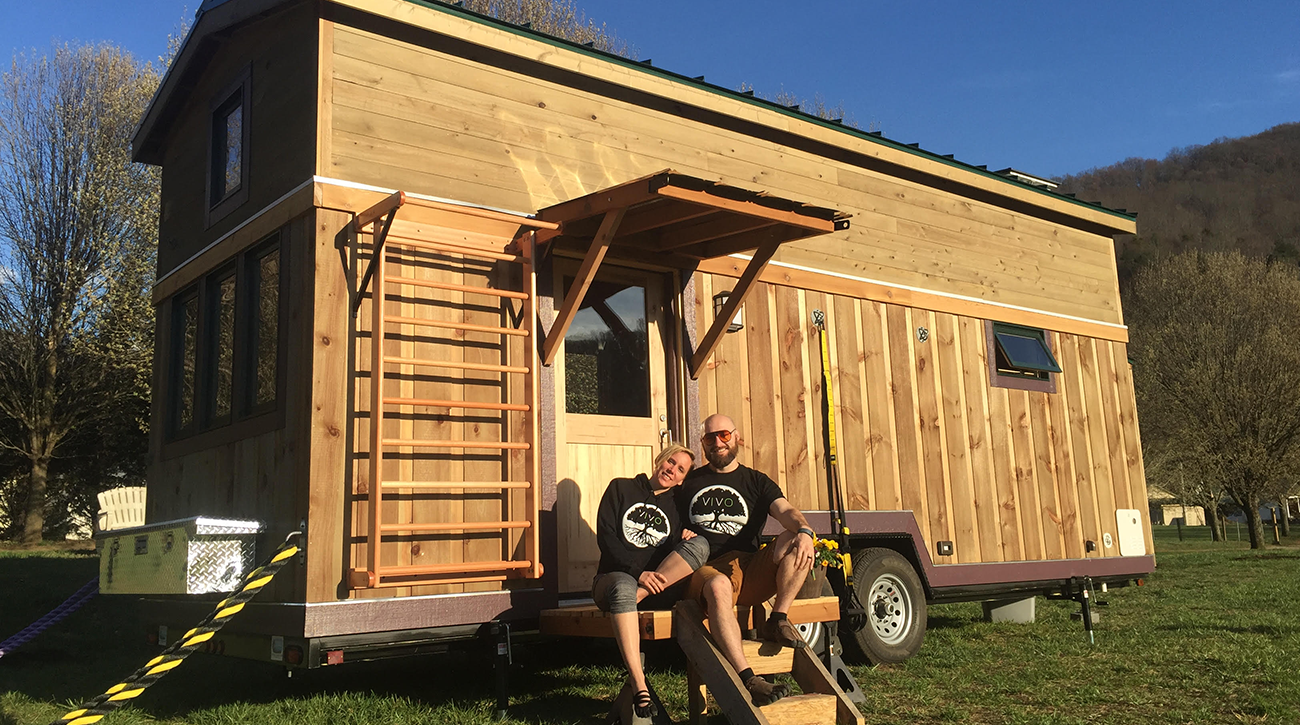When house-hunting, your “must-have” list may include things like three bedrooms, two baths and as we often hear, it’s all about location, location, location. For Milken Institute School of Public Health (Milken Institute SPH) student Mike De Vivo, that list looked a little different – under 400 square feet, easy to transport and a sustainable design with fitness features built in. So in the summer of 2015, De Vivo and his wife Jasmine started the process of building their tiny dream home, landing them a spot on the HGTV show Tiny House, Big Living.
De Vivo loves the DC area, but found that renting or financing a home in the region weren’t viable options, especially as they work to grow their fitness company Vivo Training Systems. Through the tiny home, “we could be closer to family and pay off a tiny house in less time than paying rent on a place,” De Vivo says. “Plus, we have a baby on the way and we want our baby to have access to those things we prioritize—family, the outdoors, and a more simple, healthy life.”
Before choosing a builder, the De Vivos spent 3-4 months conducting research before finally selecting Blue Ridge Tiny Homes in Barnardsville, NC. They wanted a builder who focused on quality woodwork and design, but location was important as well to save on transportation costs of having the home delivered once completed.
Their home is equipped with features that complement the De Vivos healthy lifestyle such as a climbing wall on the back exterior wall of the house, TRX hookups on the front exterior and a rope to climb up to the interior loft space. It’s also a sustainably-designed space made from all natural materials including locally-sourced ambrosia Maplewood, insulation and piping materials, non-toxic paint and a “fancy compost toilet,” as De Vivo says.
De Vivo plans to use the tiny home building process towards his Culminating Experience required for graduation from the Master of Public Health in public health communications and marketing at Milken Institute SPH. “I’m doing a quantified self-study,” he says, tracking general health parameters to see how they change once he moves into the tiny house. “I want to use methods I’ve been using in school to analyze that.”
Another aspect of the MPH curriculum De Vivo has seen play out in this process is the concept of behavior change. “By designing your environment with specific intentions, you can make those behaviors happen,” he says. Adding that behavior change psychology was useful in helping him identify the priorities around designing his home, and how that will affect his health and habits through the fitness-focused and sustainable features. Classes in his program also made him more confident in reaching out to people in the tiny house field. “We talked about these things in my classes—how to contact the head of an organization and talk to them about your projects and research, and how to have a balanced dialogue,” De Vivo says. “That’s the big picture I got from my degree and classes.”
The whole experience of building a tiny house and having it documented has been an eye-opening adventure for the De Vivos and they anticipate they will continue to grow and learn once they move into their new home. He admits that being filmed throughout the process was a little weird at first, but having the same producers and much of the same camera crew for most of the shoot helped them feel more comfortable on camera and develop a close relationship with the crew over the five-month filming period.
“This will be a very big test of how well we know ourselves when we move into this house,” says De Vivo. “It’s going to help us grow quickly in terms of how we perceive our needs and what we want to do with our lifestyle.” The HGTV Tiny House, Big Living episode featuring Jasmine and Mike De Vivo aired on May 16, 2016.


